A day in Siena stop by stop
Have you planned to spend a whole day in Siena? Let me guess, you realized there are so many interesting things to see and you don’t know what to choose? No problem, your guide is here 😉
It’s true, Siena is a tiny city and yet it is full of treasures. Most of them are concentrated in its historic center, a Unesco heritage site. So don’t worry, in one day you will manage to visit the most iconic places of this city.
Follow the step-by-step guide and you will not only save time but also manage to enjoy your experience in this very special city to the fullest.
Let’s start with the morning. To optimize your time, I would recommend parking near the Basilica of San Domenico. There are two very convenient paid parking lots near the church: Parking la Fortezza or Parking lo Stadio.
Of course, there are also non-paying places (like this one) but they are hard to find, you risk losing quite a bit of time, especially if you plan to arrive in Siena on Wednesday morning: it’s market day!
But if you are of those who like to do things slowly, without stress and especially without getting up early, you will have already arrived in Siena the night before, right?
Anyway, I hope you are as fresh as a rose in the morning in front of the Basilica of San Domenico.
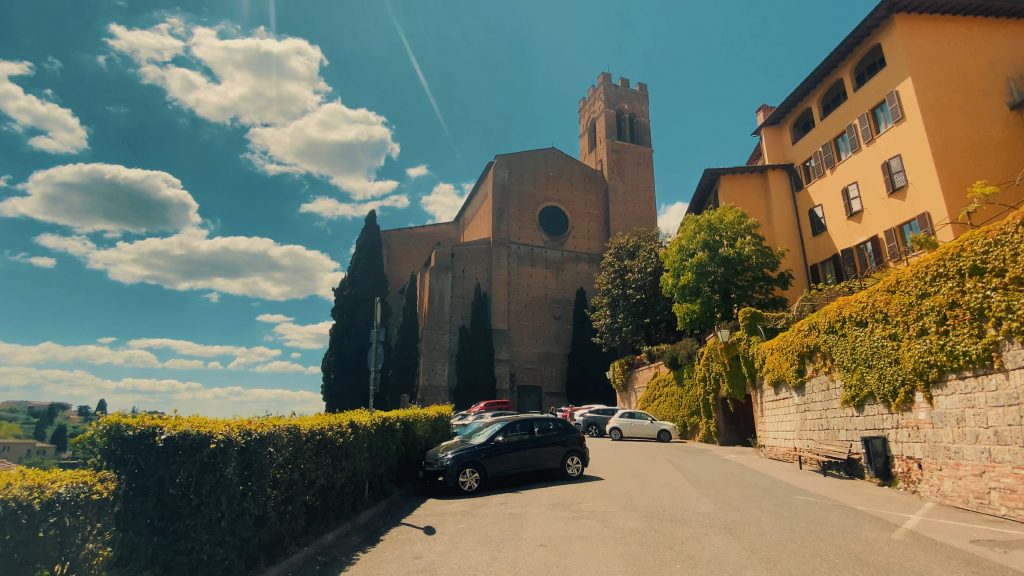
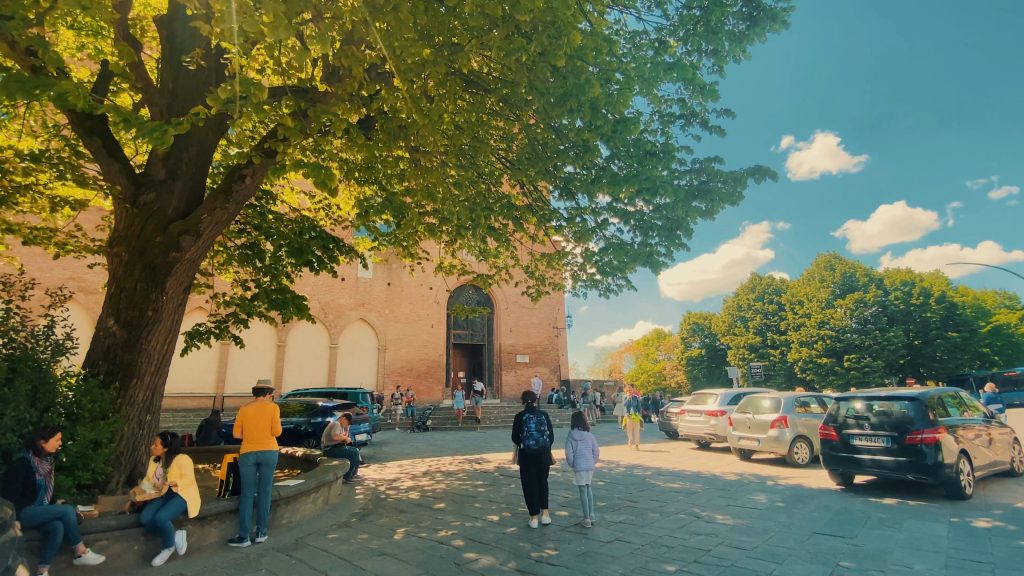

It is one of the most important places in Siena. Commissioned by Dominican mendicant friars. Here, the adolescent Sienese saint Catherine took her vows. So it is no coincidence that her relics are kept here: her head and the thumb of her right hand.
Exit the church and head to the right, into the church square, at the end you will find a spot where you can enjoy the view of Siena, an all-medieval skyline!
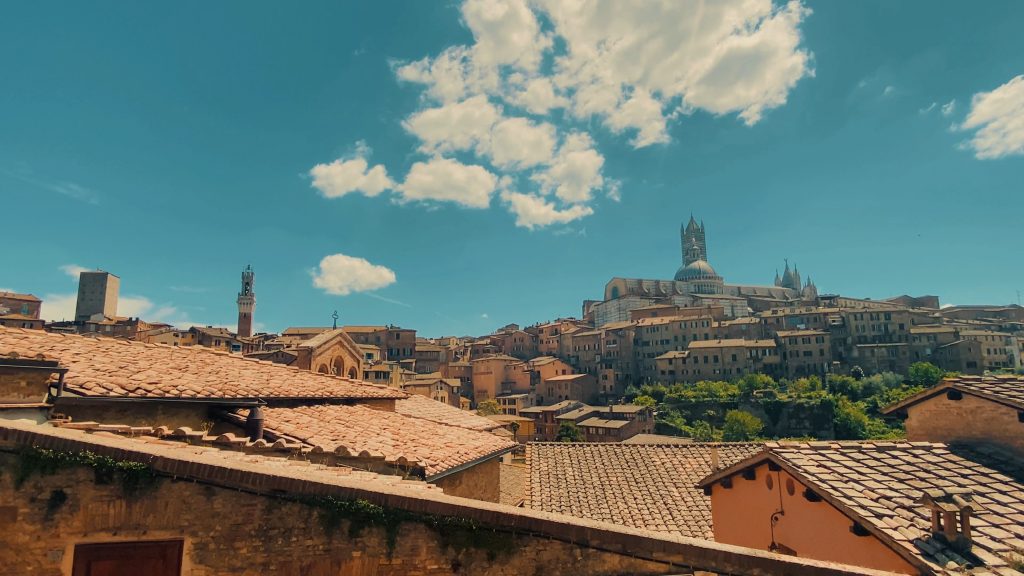
Continue down Via della Sapienza until you come to one of the city’s main streets, Banchi di Sopra. In front of you is a square, Piazza Salimbeni, overlooked by the fortress of the family of the same name, now home to the world’s longest-running bank, Monte dei Paschi di Siena.
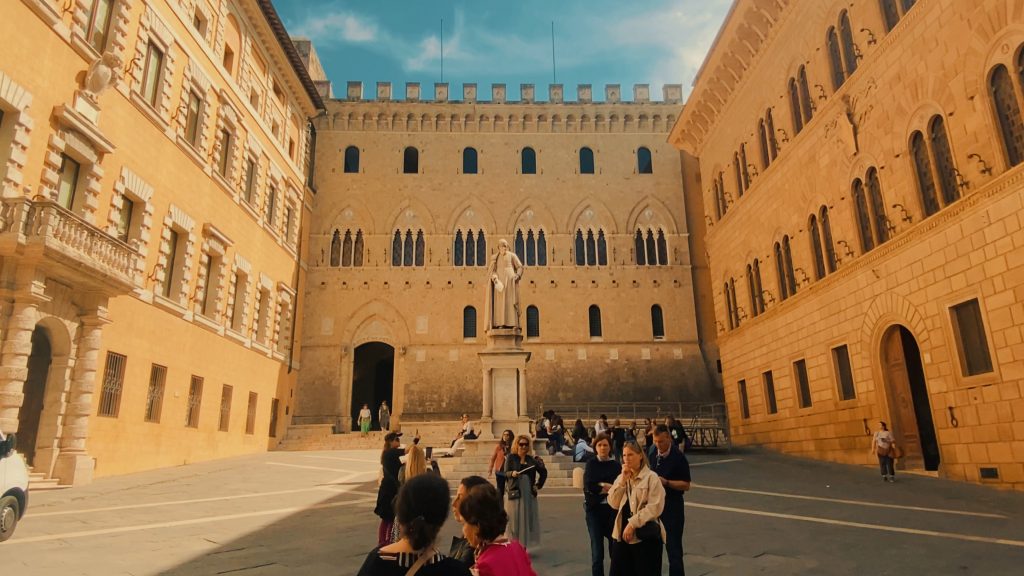
Continue to Banchi di Sopra and on the left, you will find Piazza Tolomei, with the Church of San Cristoforo, where the priors of the Republic of Siena, in 1260 decided to wage war against Florence meeting them at Montaperti. Epic battle that saw the Sienese victorious. Opposite the church is the 13th-century Palazzo Tolomei, from which the square takes its name. This family, very influential in the Middle Ages, was made famous by Dante Alighieri, who meets one of its members in Purgatorio: Pia de’ Tolomei (Purgatorio, Canto V, 130-136).
Walk down to Piazza del Campo but first stop at the Croce del Travaglio. Here there is a loggia called the Loggia della Mercanzia with frescoed vaults gracing the seat of the Arte della Mercanzia of the Republic of Siena. Both the structure and the statues are 15th-century. In particular the statues, besides St. Peter and St. Paul there are 3 of the 4 patron saints of Siena: St. Savino, St. Ansano and St. Victor.
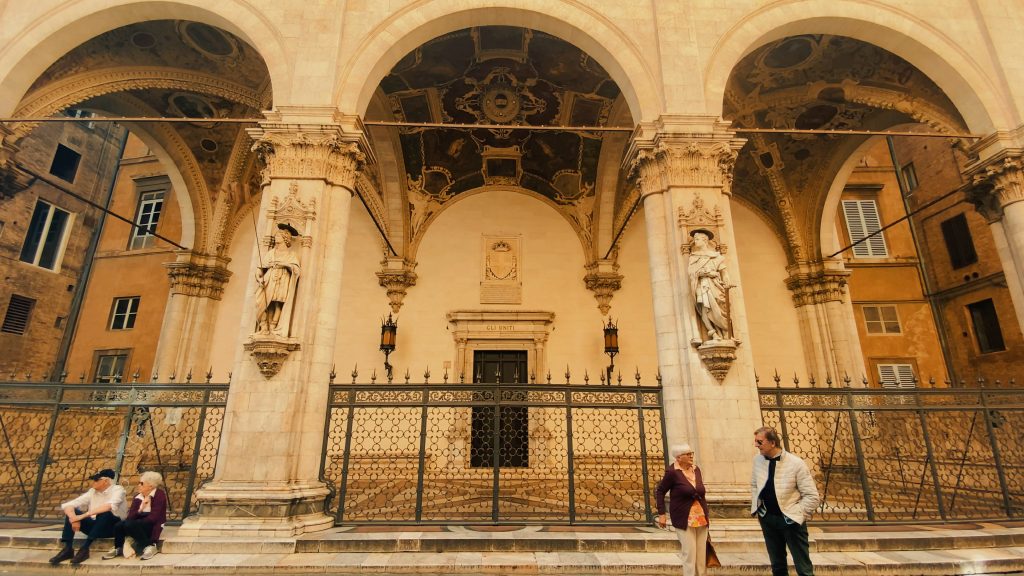
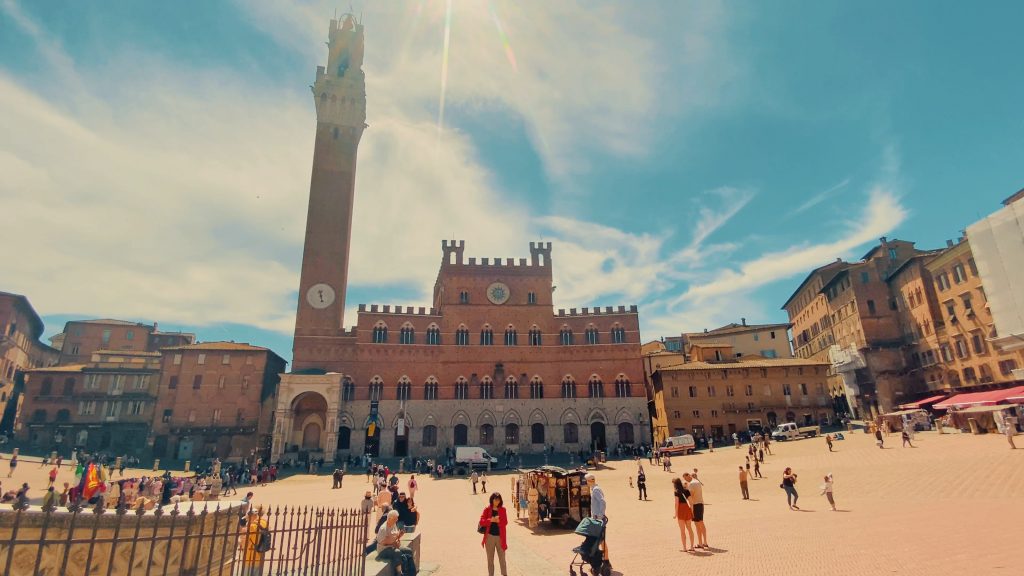
Now go down the stairs along Vicolo di San Pietro and…..voilà! Did you just say “wow”?
You are in Piazza del Campo, a historic place as well as the nerve center of Sienese life. Here, twice a year, the most famous horse race, the Palio, is run. Siena is divided into 17 contrade, and these contrade compete for the so-called “cencio,” the palio, or prize.
It consists of 3 laps around the square, totaling about 75 seconds of pure delirium! It is worth seeing at least once in a lifetime!
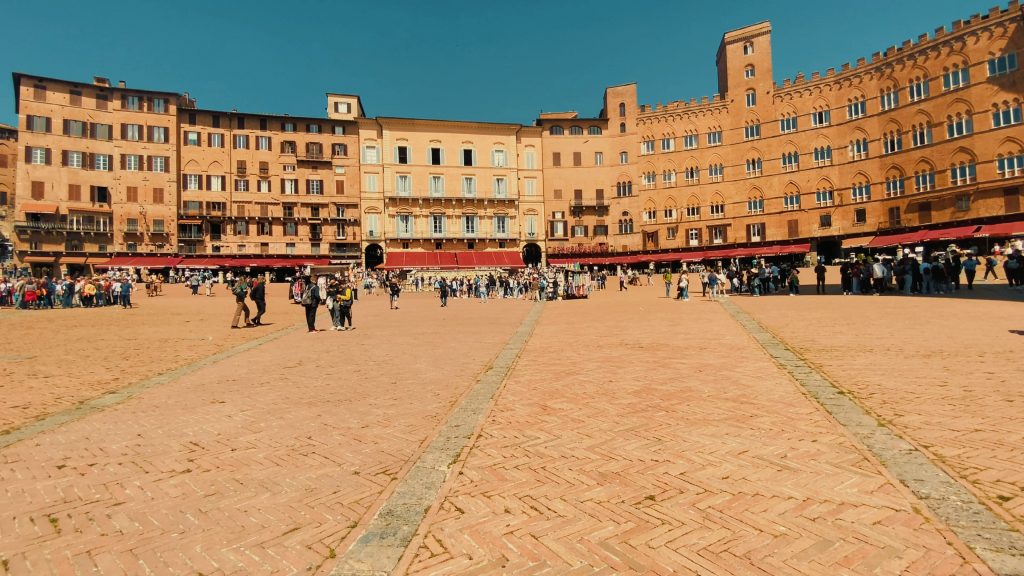
But Piazza del Campo and the Palazzo Pubblico existed centuries before the Palio tradition as we know it today.
The Palazzo Pubblico and the square were commissioned by the government of the Nine: by this time the government had become a complex body, the priors could no longer meet in the churches, so they needed a palace that could house all the government offices, and even the prisons!
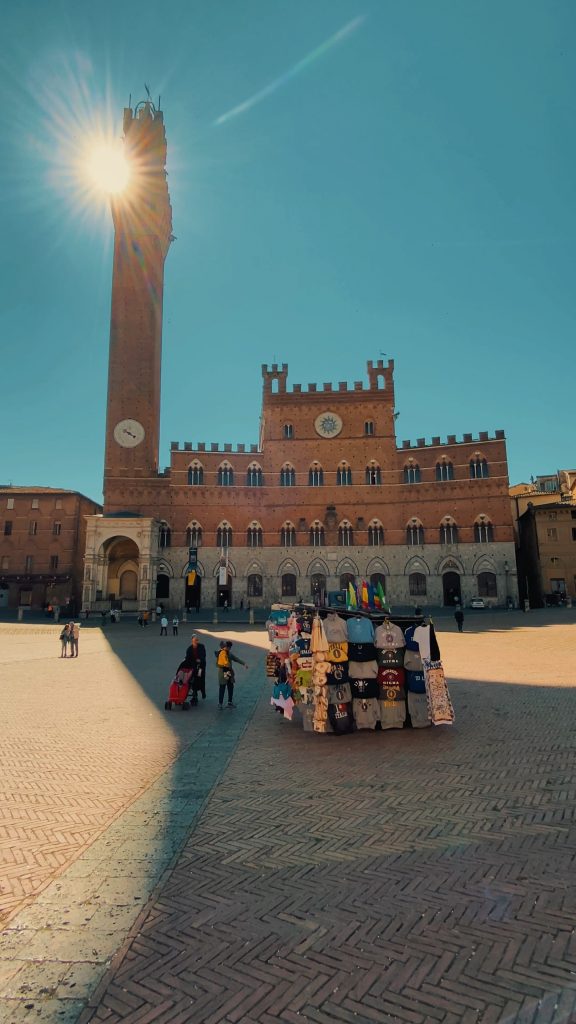
There is also a fountain in the square, Fonte Gaia, named so because the Sienese struggled for many years before having water in the city center-keep in mind that unlike Florence, for example, Siena has no river. So the joy was so great that they decided to call it Gaia (it stands for joyful) and inaugurated it in 1346. Between 1409 and 1419, the Sienese artist Jacopo della Quercia was responsible for embellishing it. What you see, however, is a copy; the original, a bit more worn by time, is kept in the Museum of Santa Maria della Scala.
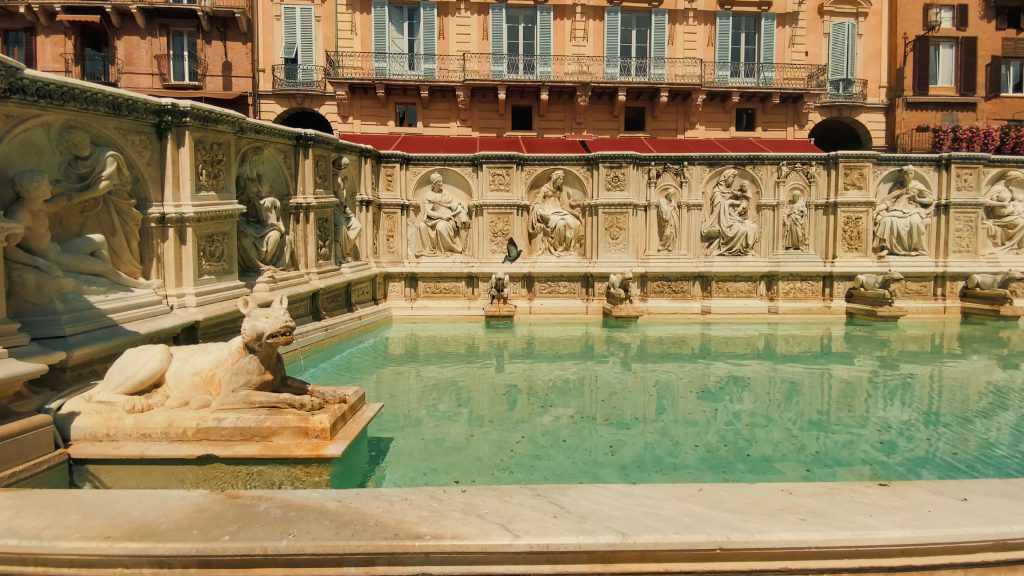
If you have come to Siena in the summer you will notice many people in the square following the shadow of the majestic Torre del Mangia. Named after its first bell ringer. This one’s name was Guido di Balduccio, but since he was famous for spending everything he earned in taverns drinking and eating, the Sienese nicknamed him the “Mangia Guadagni” (Wages Eater), just “Mangia” to his friends.
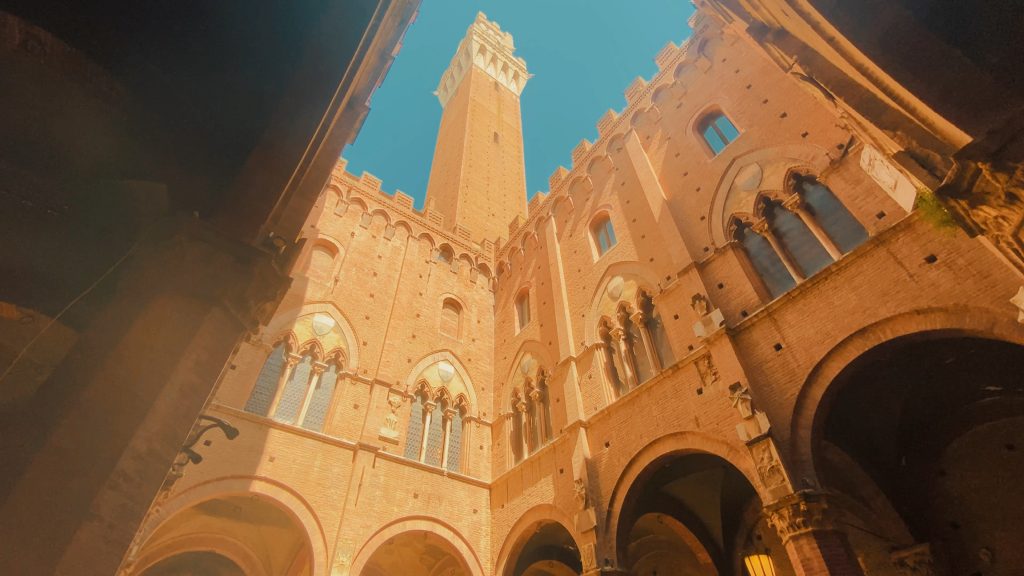
Now enter the Palazzo Pubblico, the entrance on the left. Enter what was once the Courtyard of the Podestà but is now called the “Entrone” by the Sienese: this is where the horses are kept before the race.
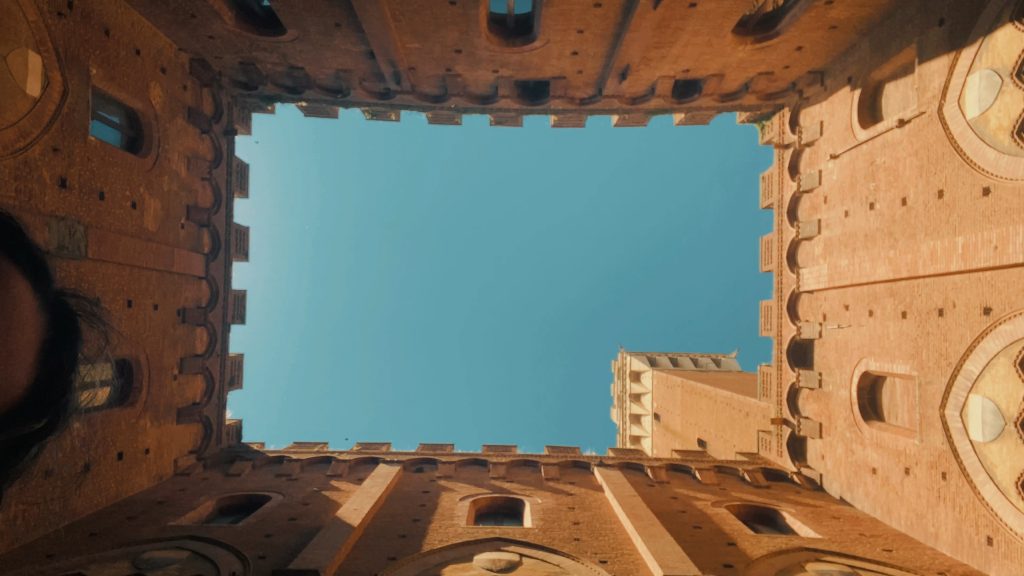
In the courtyard, you will find the she-wolf, the Sienese emblem, and the ticket office. Buy your ticket and visit the marvelous Museo Civico where you will find works by the greatest exponents of Gothic art such as Simone Martini with his Maestà and Guidoriccio da Fogliano, Ambrogio Lorenzetti with his magnificent fresco that covers as many as three walls of the Sala della Pace, I am talking about the very famous Allegory of Good Government. We find The Presa Giuncarico attributed to Duccio di Buoninsegna, frescoes by Taddeo di Bartolo and Beccafumi. All in the original spaces of the former seat of the Sienese government.
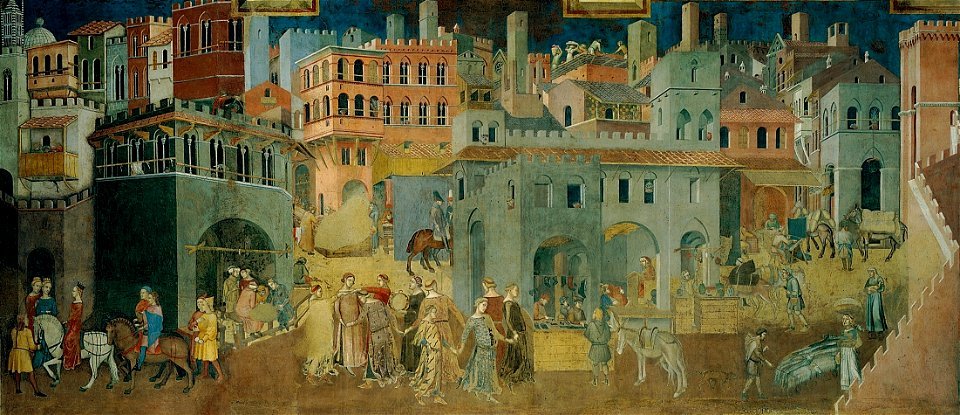
I would say it is time for a well-deserved lunch break.
I will not suggest restaurants as it would be an endless list and a lot depends on your taste and budget. Surely online, on Trip advisor, for example, you will find what is right for you.
Finished eating? Ready to go again? Then let’s head to what was once the religious center of the city: Piazza del Duomo. If you have eaten too much and are trying to digest quickly, I suggest you take the stairs that run alongside the Baptistery where you will find a cross indicating the place where St. Catherine fell pushed by the devil.
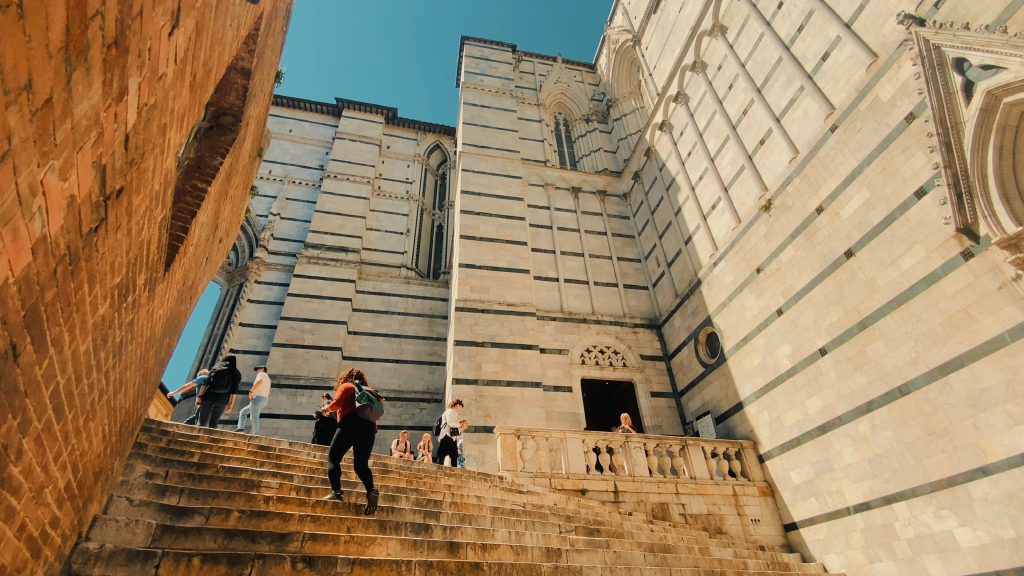
Go through the Gothic portal and you will be in Piazza Jacopo della Quercia where you will find the remains of what is called the “Duomo Nuovo” (New Cathedral). In the fourteenth century, the project to enlarge the cathedral was started, but unfortunately in 1348 the plague arrived, the work stopped, and more than 60 percent of the population died. There are no more resources to continue, plus there are also structural problems: the Sienese have to give up the project.
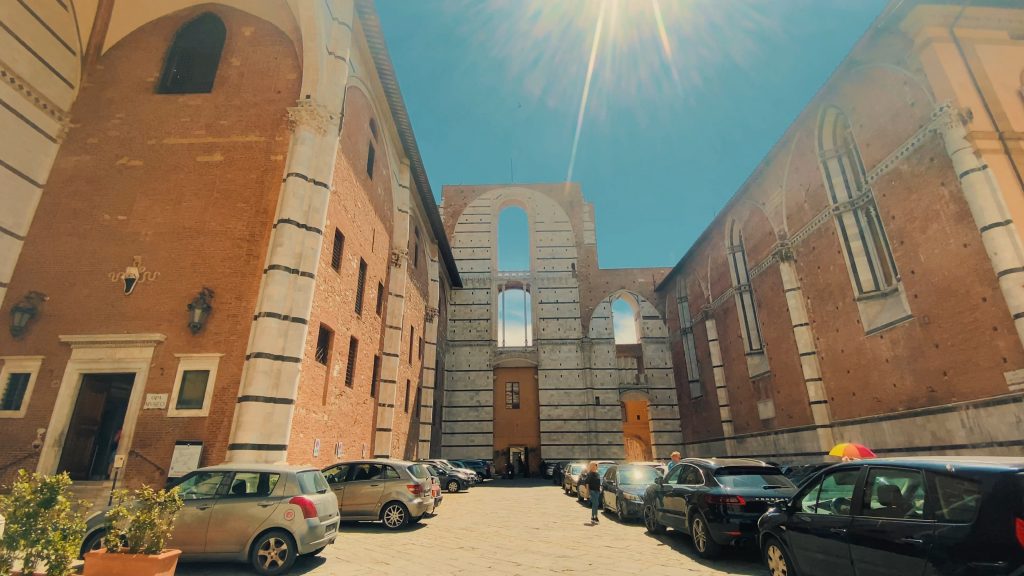
Now move to the Piazza del Duomo, where you can admire its facade partially designed and decorated by Giovanni Pisano and his school. Famous are the statues that decorate the first register, those above the portals. They represent philosophers, prophets and sibyls: statues for the first time untethered from the architecture, free to move, free to dialogue with each other.
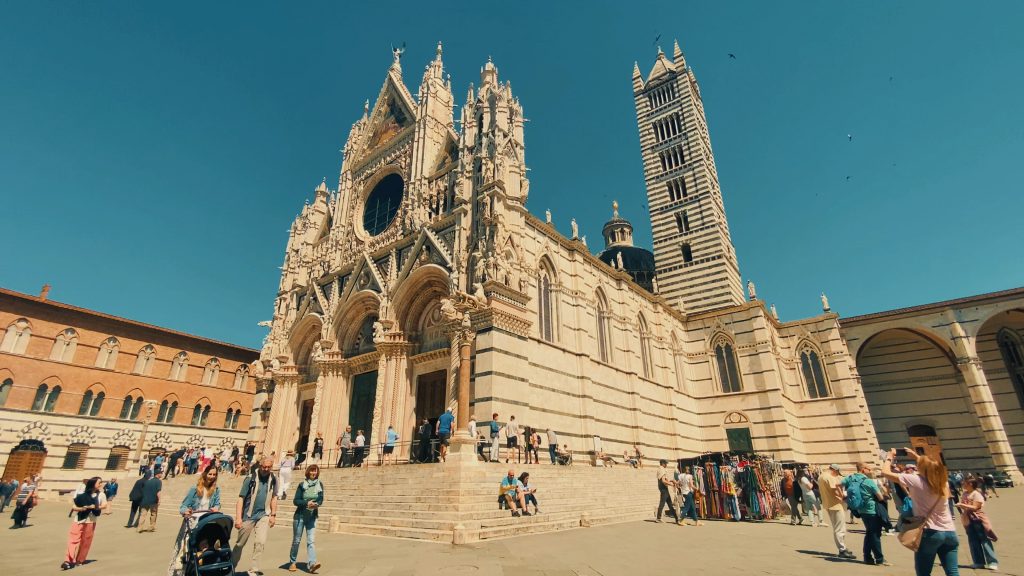
Skirt on the left side of the Cathedral where you can find the ticket office. It’s up to you to choose whether to visit just the Cathedral or the whole complex which also includes the Crypt, Baptistery, and the Opa Museum where other works of art that were once in the Cathedral such as Duccio di Buoninsegna‘s famous Maestà are kept. Or you can buy the “Gates of Heaven” ticket where you can admire the cathedral from above complete with panoramic views from the church rooftops.
In my opinion, this kind of route, the one from above, is very worth doing when the famous floor of the Cathedral is uncovered. It is uncovered only at a certain time of the year. This year, 2023, from June 27 to October 18. Giorgio Vasari called it the most beautiful floor ever seen, and if he says so…
I assure you that it is worth it, at least to visit the cathedral, since inside you can admire the Piccolomini altar with statues commissioned to Michelangelo, the Piccolomini Library, entirely frescoed by Pinturicchio with the most famous episodes from the life of the Sienese Enea Silvio Piccolomini, most famous as Pope Pius II. Apparently, helping him with the preparatory drawings was Raphael as well.
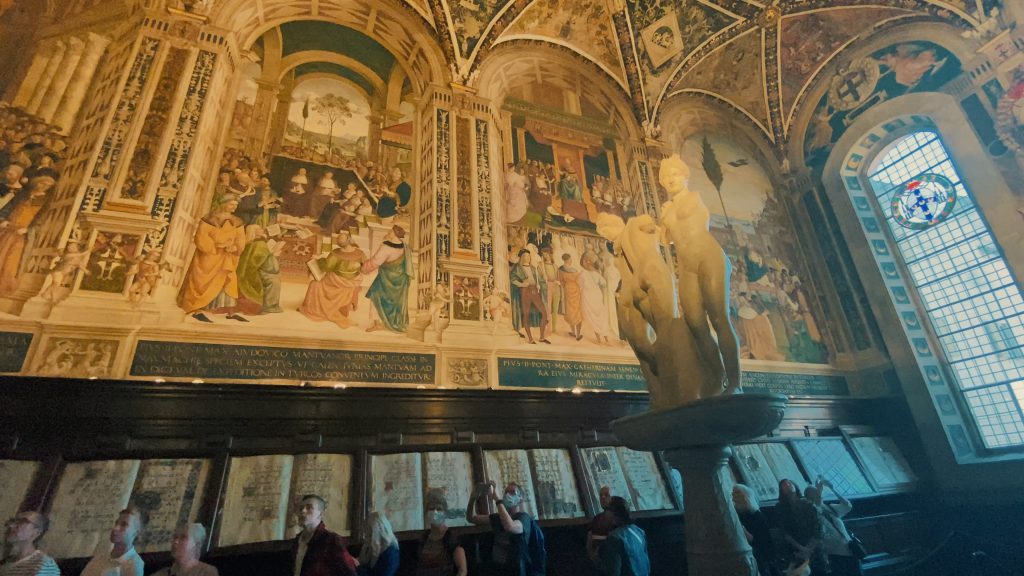
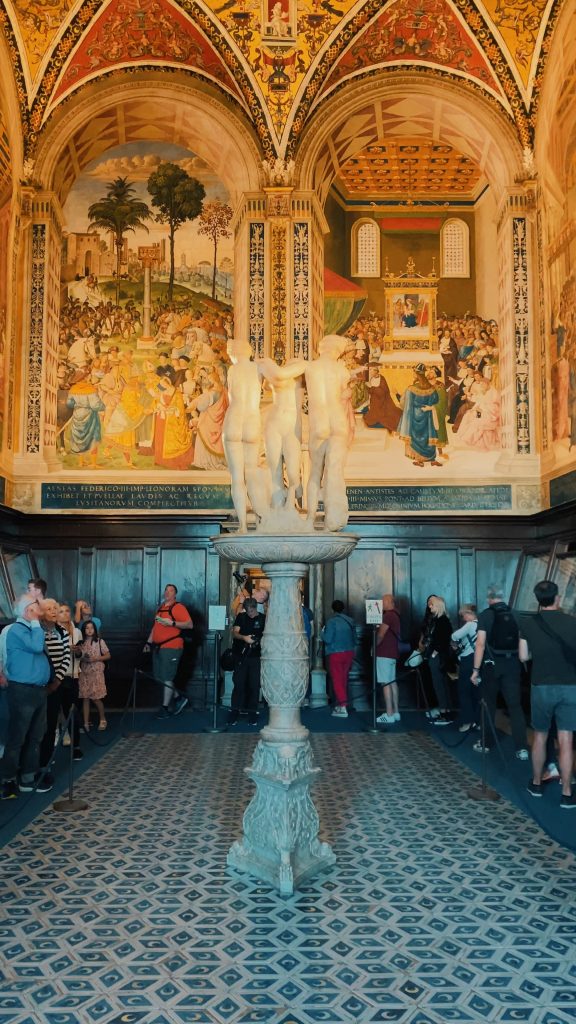
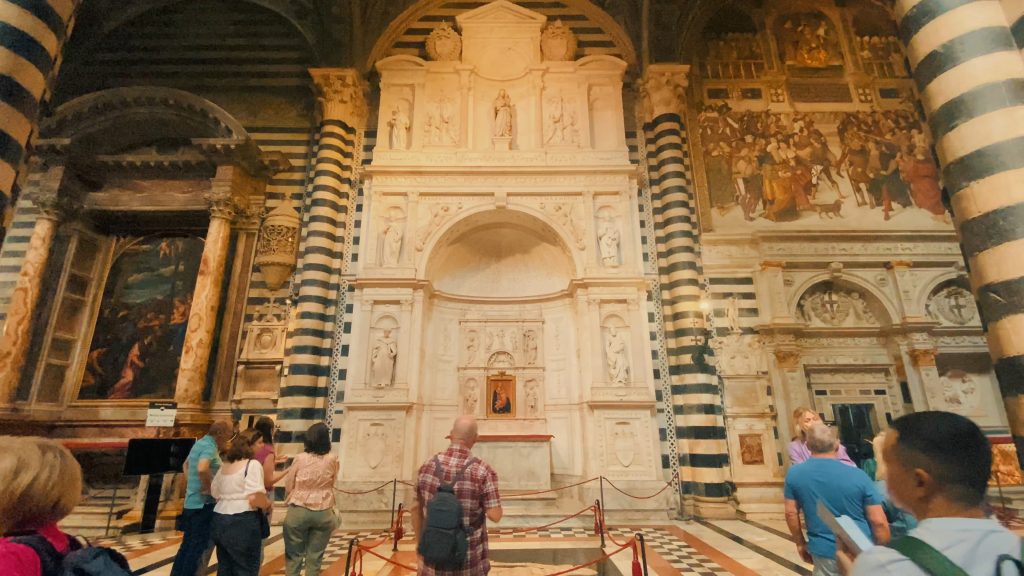
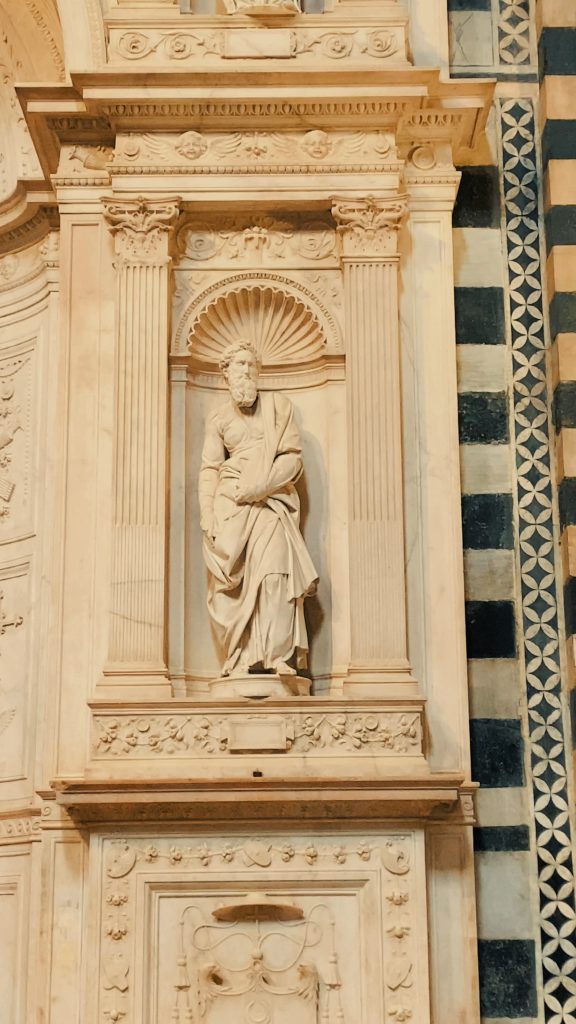
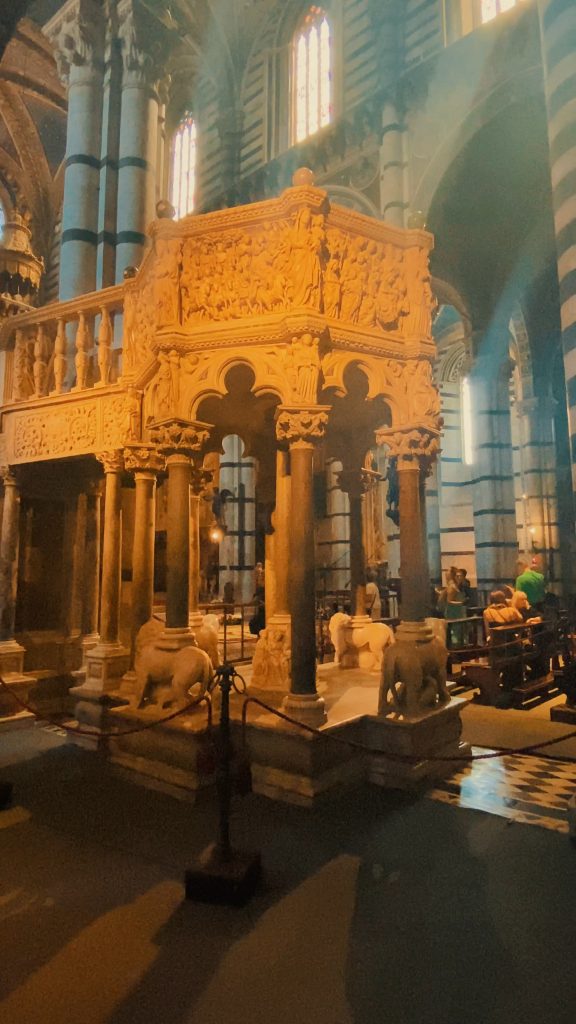
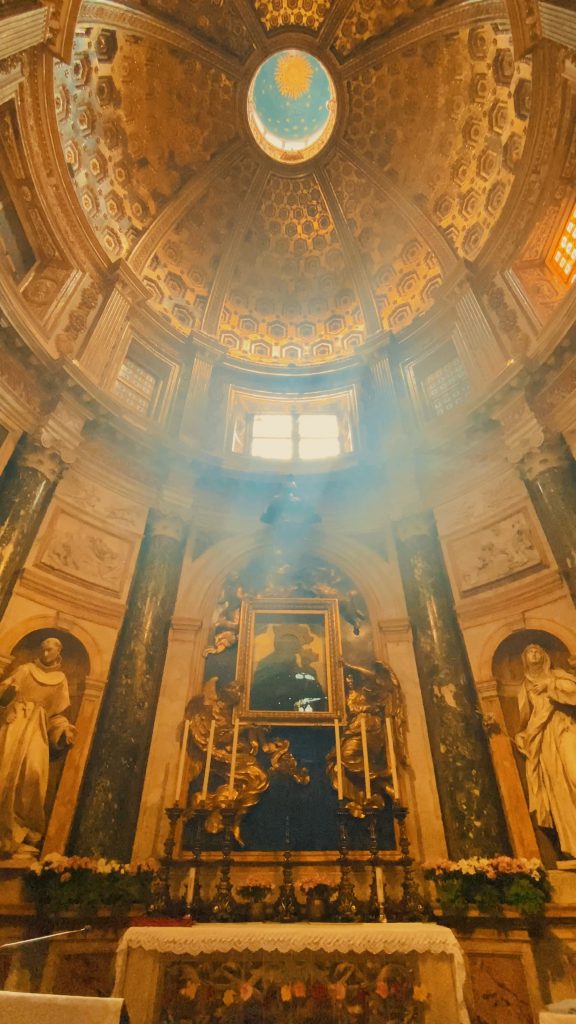
Then there is the statue of St. John the Baptist executed by Donatello in the chapel of the same name. Donatello is also commissioned for a tomb slab of Bishop Giovanni Pecci. Perfect in its foreshortening rendered with the “stiacciato” technique.
Stop to admire the Pulpit, a masterpiece by Nicola Pisano, aided by his son Giovanni and the famous Arnolfo di Cambio. Go around it and you will read like a comic book the entire New Testament up to the Last Judgment.
To conclude cross the transept and head for the Chapel of the Madonna del Voto. Here is preserved the image of the Madonna, known as the Madonna del Voto precisely, considered the main and most venerated Marian icon in the City; it is given the title of Advocata Senensium. Commissioned by the Sienese from the Sienese painter Dietisalvi di Speme, as thanksgiving for the victory in the Battle of Montaperti. We talked about it earlier when you were in Tolomei Square, remember?
It was commissioned by the Sienese pope Alexander VII, taking advantage of the Baroque flair of Gian Lorenzo Bernini, who, inside the chapel, leaves us two statues placed on the counter-façade: St. Mary Magdalene and St. Jerome.
I would say that we can now move from the sacred to the profane. If you really want to get into the Sienese spirit, you absolutely must visit the headquarters of a Contrada (district). Not all of them allow access though. The ones that are more convenient let’s say, closer to the center and that I know best and that I know organize tours inside their headquarters are:
- Contrada Priora della Civetta in Via Cecco Angiolieri, 16 (near Piazza del Campo)
- Contrada Capitana dell’ Onda in Via Giovanni Duprè, 103 (near Piazza del Campo)
- Contrada della Selva, in Piazzetta della Selva (very close to the Cathedral).
Below I list their websites where you can find contact information to book a visit.
- Civetta
cancelleria@contradadellacivetta.it - Onda
mond@contradacapitanadellonda.com - Selva
economatocontradadellaselva@gmail.com
Some Contrade accept simple donations while others have a fixed fee. I recommend that you contact them since being organized on a volunteer basis they do not always guarantee service. Also if these contrade are participating in the upcoming Palio they are busy in preparation and therefore not always available for a tour.
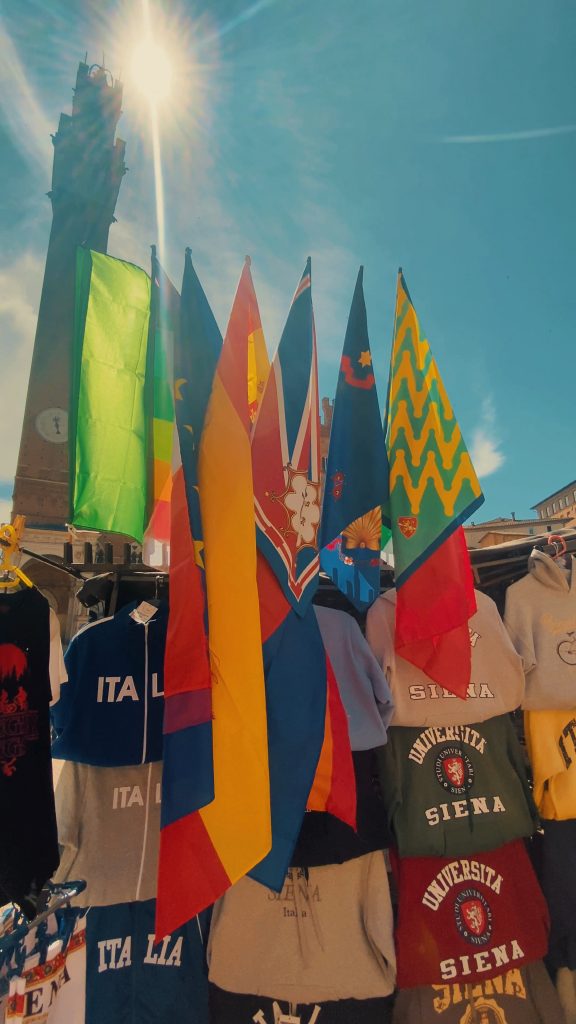
Nice full day, huh? But it doesn’t end there. Don’t worry just a couple more suggestions. If you still have the energy and came to Siena during the day of the Palio you really don’t want to miss the race in the Piazza (where it’s free), right?
On this site you will find all the info you need to get around the city on the most exciting day for the Sienese. There are rules and cautions to observe because it is a day where tension and exhilaration are at their highest levels.
Besides, after the race, don’t you want to see the festivities?
But in case you are in Siena on an “ordinary” day, I would say you can go relax and enjoy the sunset at the Fortezza Medicea (Medici Fortress). There are gardens and a walking path often used by those who, even in the hot summer sun, want to keep fit with a jog. During warm weather, you will find outdoor bars where you can enjoy an aperitif with a city view!

As always, I hope this mini-guide has helped you enjoy Siena. Let me know in the comments if possible.
But if you want to know more, if you want to understand how this city became the beauty it is, who were the characters that made it unique, then you know what to do: contact me and let’s organize your experience in Siena to do together!